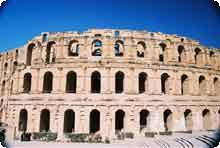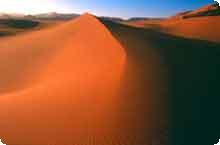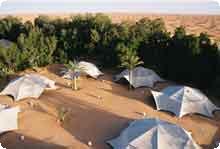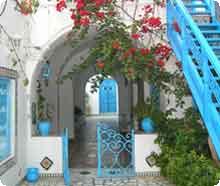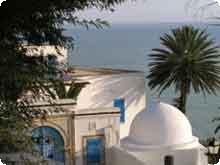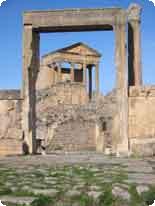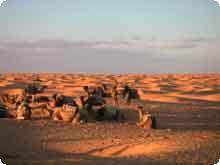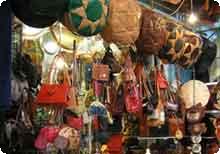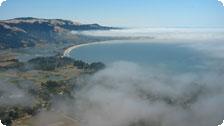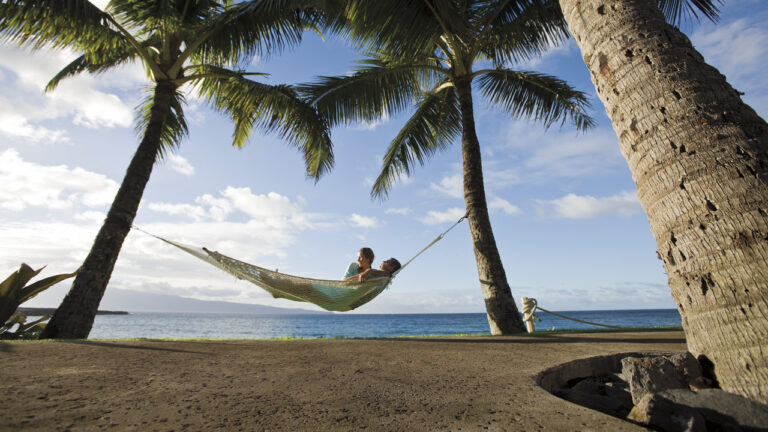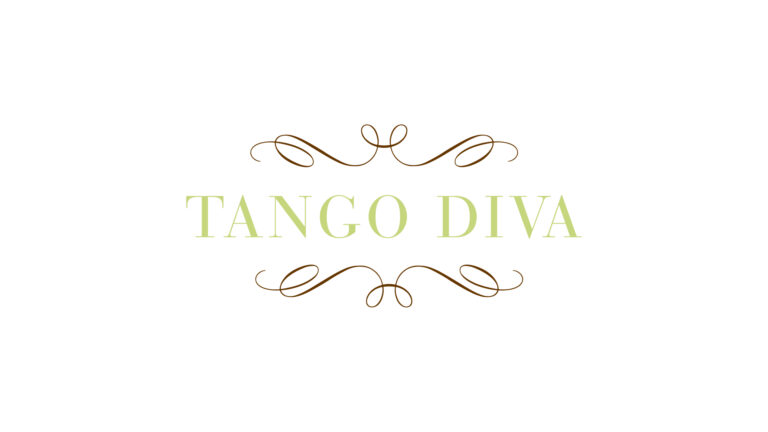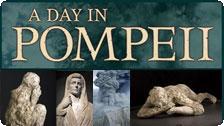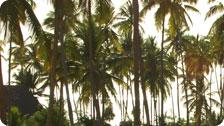Culture: Tunisia
by Suzanne Wright
With its cosmopolitan cities, Roman temples, stunning hotels, and the grandeur of the Sahara, this North African Country holds numerous surprises for visitors.
A message has been delivered to my room, in French. With my rusty, rudimentary high school language skills I can’t quite make it out, so I call the front desk to ask for help in translating it. A handsome man, maybe fifty, appears at my door. Learning I am American, a broad smile spreads across his face.
“We have been friends for three hundred years,” he says, shaking my hand enthusiastically. I’m not sure, but I think he tells me that the US helped liberate Tunisia from France. I smile back; words are sometimes unnecessary.
Tunisia is one of those places people can’t quite place. Is it in the Middle East? Africa? Europe? I’ve come on a ten-day tour with PromoTunisia to get an overview of this beautiful, varied, educated, and prosperous (eighty-four percent literacy, a large middle class, with an eighty percent home-ownership rate) North African country. Many Europeans come here for the sun and the thalassotherapy, supervised medical spa treatments that use sea water. In fact, Tunisia is second only to France in thalassotherapy spas, and much less expensive. I’ve come for the Roman ruins (3,000 years worth), the landscape (coasts, desert, cities), the food, and the friendly people.
After flying into the capital of Tunis, home to two million people, we head to Sidi Bou Said on the Mediterranean coast, twelve miles north of Tunis. With its whitewashed buildings brightened by blue windows and doors and a perch over the water, it reminds me of Santorini, Greece. Referred to as the “Tunisian Riviera,” the nation’s President Ben Ali and many ambassadors live here. Our lunch at Le Grand Bleu, with its water views, is wonderfully simple and delicious: squid, prawns, sepia (with a texture like sweetbreads), and the sea bass cooked in salt and served with a squeeze of fresh lemon.
Our small group wanders the narrow streets of this UNESCO World Heritage Site enjoying the sights: shopkeepers selling red and black chechias, the tight-fitting cap so many men wear; cats paddling languidly across the cobblestones; a man pressing fresh orange juice. We nibble on beignet-like, sugar-covered sweet with a hole in the middle called a bambalouni. As the day lengthens, we are soon the only tourists in sight. Our wonderful residence du charme, Dar Said, is a delightful small inn. My room, #25, has a rooftop terrace and a wonderful sunken tub in a blue and white tiled alcove.
After dinner at the posh Au Bon Vieux Temps, we sit at a Café Sidi Chabaane that overlooks the Bay of Tunis, the silvery moon on her back, the twinkling lights of the city in the distance, as we sip mint tea with pine nuts and smoke apple-flavored tobacco from a chicha, a giant water pipe shared between friends.
The next morning, we visit the Bardo National Museum, with a collection of mosaics unmatched in the world, including several of the famed Ulysses. Our guide, Mohamed, is excellent as he highlights the treasures of Tunisian history, from pre-historic times to Punic civilization, the Roman era to Christian times, and Muslim culture to the twentieth century.
Next we tour a few of the fourteen sites scattered across the area that comprises Carthage, the proud city that made Rome tremble, and another UNESCO World Heritage Site, to get a feel for the monuments of the city that was ruled in turn by Punics, Romans, Vandals, and Byzantines. In the evening, we dine at Essaraya, one of finest restaurants in Tunis, located in the medina, or old city. The food just keeps coming, including a finely grained couscous, which we ladle with tomato sauce loaded with carrots, garbanzos, potatoes, and onions. By now, we are all pros at smearing harissa, a spicy condiment which Mohamed calls “Tunisian marmalade,” on everything from bread to eggs to lamb. Zriga, a dessert cream scented with rosewater, almonds, pistachios, and pine nuts, is a wonderful finish.
The next morning, luggage and six people clamber into a 4 x 4, our home for the next seven days, and set off for Dougga, the best-preserved Roman city in Africa, set on a green hill overlooking a fertile plain. First we stop at Testour, an Andalucian village where the street market is alive with energy: merchants sell frankincense, turkeys, clothes, and vegetables, and men in heavy woolen brown burnooses, robes with hoods, keep one arm free to drink tea at sidewalk cafes and carry packages. Dougga, dating from AD 169, is impressive, its ruins deeply evocative of the time and its fields, orchards, and groves hinting of Tuscany. A young boy of thirteen tends to a flock of sheep.
As we drive onto Kairouan, the topography changes from scrubby—we even spot a tumbleweed—to lush, with blooming almond trees, olive groves, vineyards, and “living fences,” made of stalwart cactus. We check into Hotel La Kasbah, a very chic hotel that merges harmoniously with the Arab-Islamic architecture of the town, renowned for its rug-making. Wandering the medina, just steps away, we sample the makroudh, a local pastry stuffed with dates, and I succumb to a beautiful rug for my hallway. Back at the hotel, I note the heavy key is in the shape of the hand of Fatima, who protects one from evil spirits.
The next morning we visit the ninth century mosque of Uqba Ibn Nafi. Kairouan, a pretty town made up of low-lying, white buildings with the jutting spires of numerous minarets visible, is the fourth holy place of Islam after Mecca, Medina, and Jerusalem. Then it’s off to El Jem, the second largest amphitheater in the world—second only to Rome—which stands out like a colossus of stone cutting the horizon of these arid plains. Walking the elliptical coliseum, I can almost feel the thrill of the games, the sights and the sounds of the combat between gladiators and wild animals.
We want to reach the Sahara by sunset, so we make only one stop, at Matmata, to visit the famous troglodytes, homes built into the mountain. George Lucas and Steven Spielberg used its Berber villages with their pitted, strangely lunar landscapes in the films Star Wars and Indiana Jones: Raiders of the Last Ark. Lazhar, our driver, tells us to buckle up as he unbuckles his seatbelt to better feel the dunes. He knows this landscape and deftly speeds or slows, so we sail over the sand and we laugh as if on a roller coaster. Once we’ve stopped, I kick my shoes off and bury my toes in the soft, welcoming sand.
We arrive at Pansea Ksar Ghilane, a luxury tented camp with private bathrooms, in the ocher-colored dunes. We ride camels to a Roman fort at the top of the dunes, as the sun tinges from yellow to red. There a Bedouin man demonstrates bread making, mixing flour, water, and salt and buries it in the sand beneath hot coals. A few minutes later, he pulls the round loaf from the sand, brushes it off, and hands it to us. Tearing off a hunk, I savor its delicious, grilled, slightly chewy texture with an assortment of kemia, snacks such as olives, tuna, and spreads like mashed carrots with olive oil, salt, pepper, and parsley.
Torches stuck in the sand lead to a low table set with candles, linens, and gypsum rock, the “sand rose of the Sahara,” under a tent strewn with gorgeous rugs; this is dinner in the desert. We have four courses, including brik, fried pastries filled with tuna, shrimp or egg, and lamb that has been cooked in a clay jar and is dramatically cracked to release the fragrant meat. A Bedouin plays lyrical flute. One of our waiters, thirty years old, tells me his life is very good: he’s got a job at the resort and his parents live walking distance away in the desert, sleeping under the stars. I agree with a smile. The desert is magical, spiritual.
The following morning we head toward Douz, where we rent four-wheelers to surf the sands of the Sahara. I feel both guilty and giddy, as we whirr through the amber sands, passing other tourists on camels. We head onward to Tozeur, crossing the salty Chott el Jerid, where mirages seem to appear from the reflected light that hits the sand. We are only 150 miles from Algeria. Later, we visit a nomad family and I befriend a sweet lamb.
Our hotel, the Dar Cheraiet, in Tozeur, has a comfortable mix of faded European furniture and Tunisian architecture, along with a fantastic folk art museum in a traditional house with a series of interconnected rooms. Best of all, it’s open until midnight. I’m not a fan of the “1001 Nights” dinner show, but I do enjoy the desert basket with intoxicatingly perfumed oranges and the most succulent, nearly translucent dates, deglet nour, “fingers of light” in Arabic.
At breakfast, I discover merguez, flavorful baby sausages of minced lamb and beef, another culinary triumph. Then we drive to the Metlaoui train station, where we board the Lezard Rouge (Red Lizard), which, in colonial days, was the private transport of the Bay of Tunisia. For almost two hours, we pass through the breathtaking scenery of the otherwise inaccessible Selja gorges dotted with palms. After lunch at the lovely Tamerza Palace and a peek at the “ghost cities” that date from Byzantine times, we hike the mountain oases of Tamerza and Chebika, with their spectacular red canyons, reminiscent of our Southwestern states.
After a final night in Tozeur, we return to Tunis by air, where we pay a much-needed visit to sophisticated La Residence Hotel, for a sampling of the famed thalassotherapy at the elegant, marble spa. First is a hamman, or Turkish bath, where a young girl sings a mournful tune she tells me was popularized by Tunisian chanteuse Latifa Arfaoui as she vigorously exfoliates me. Next comes a Vichy shower and rose oil massage, followed by a hydromassage. In talking with a Swiss mother and son, I understand why they are here for a week; it’s a splendid oasis of another kind.
On my final day in Tunis, I explore the souks or shops of the medina, and stumble across an antique store with wonderful carved paintings. After spending three hours looking, learning and, finally, buying, I am hungry and the owner sends me to a no-name eatery in the medina. No one speaks English or French, but the chef holds up a glistening scaloppine of chicken, pan sautés it, and serves it with french fries and mashed peppers. I also buy a copy of the Latifa CD from a young woman operating a newsstand on a busy corner. As I sing a line or two of what I am looking for, a young man walks up, punches his cell phone ringer and sure enough, it is the same tune. It costs me two dollars.
Finally, I go out for a late-night pizza on the clean, bustling Avenue Habib Bourguiba, named after the country’s first president following its independence from France. In a small café, I run into Luigi, who is originally from Genoa and owns a business in Tunisia. La petite monde, we agree with a laugh, sharing a mint tea.
For information on PromoTunisia’s upcoming excursions, please call 404.966.4646 or 888.701.3202 or visit www.promotunisia.com
Discover more from Tango Diva
Subscribe to get the latest posts sent to your email.
